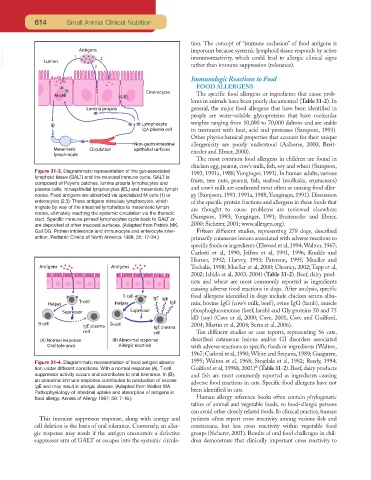Page 592 - Small Animal Clinical Nutrition 5th Edition
P. 592
614 Small Animal Clinical Nutrition
tion. The concept of “immune exclusion” of food antigens is
important because systemic lymphoid tissue responds by active
VetBooks.ir immunoreactivity, which could lead to allergic clinical signs
rather than immune suppression (tolerance).
Immunologic Reactions to Food
FOOD ALLERGENS
The specific food allergens or ingredients that cause prob-
lems in animals have been poorly documented (Table 31-2). In
general, the major food allergens that have been identified in
people are water-soluble glycoproteins that have molecular
weights ranging from 10,000 to 70,000 daltons and are stable
to treatment with heat, acid and proteases (Sampson, 1993).
Other physiochemical properties that account for their unique
allergenicity are poorly understood (Aalberse, 2000; Breit-
eneder and Ebner, 2000).
The most common food allergens in children are found in
chicken egg, peanut, cow’s milk, fish, soy and wheat (Sampson,
Figure 31-3. Diagrammatic representation of the gut-associated 1993, 1991a, 1988; Yunginger, 1991). In human adults, various
lymphoid tissue (GALT) and the mucosal immune cycle. GALT is fruits, tree nuts, peanut, fish, seafood (mollusks, crustaceans)
composed of Peyer’s patches, lamina propria lymphocytes and
plasma cells, intraepithelial lymphocytes (IEL) and mesenteric lymph and cow’s milk are confirmed most often as causing food aller-
nodes. Food antigens are absorbed via specialized M cells (1) or gy (Sampson, 1993, 1991a, 1988; Yunginger, 1991). Discussion
enterocytes (2,3). These antigens stimulate lymphocytes, which of the specific protein fractions and allergens in these foods that
migrate by way of the intestinal lymphatics to mesenteric lymph are thought to cause problems are reviewed elsewhere
nodes, ultimately reaching the systemic circulation via the thoracic (Sampson, 1993; Yunginger,1991; Breiteneder and Ebner,
duct. Specific immune-primed lymphocytes cycle back to GALT or
are deposited at other mucosal surfaces. (Adapted from Patrick MK, 2000; Sicherer, 2001; www.allergen.org).
Gall DG. Protein intolerance and immunocyte and enterocyte inter- Fifteen different studies, representing 278 dogs, described
action. Pediatric Clinics of North America 1988; 35: 17-34.) primarily cutaneous lesions associated with adverse reactions to
specific foods or ingredients (Elwood et al, 1994;Walton, 1967;
Carlotti et al, 1990; Jeffers et al, 1991, 1996; Kunkle and
Horner, 1992; Harvey, 1993; Paterson, 1995; Mueller and
Tsohalis, 1998; Mueller et al, 2000; Chesney, 2002; Tapp et al,
2002; Ishida et al, 2003, 2004) (Table 31-2). Beef, dairy prod-
ucts and wheat are most commonly reported as ingredients
causing adverse food reactions in dogs. After analysis, specific
food allergens identified in dogs include chicken serum albu-
min, bovine IgG (cow’s milk, beef), ovine IgG (lamb), muscle
phosphoglucomutase (beef, lamb) and Gly proteins 50 and 75
kD (soy) (Cave et al, 2000; Cave, 2001; Cave and Guilford,
2004; Martin et al, 2004; Serra et al, 2006).
Ten different studies or case reports, representing 56 cats,
described cutaneous lesions and/or GI disorders associated
with adverse reactions to specific foods or ingredients (Walton,
1967; Carlotti et al, 1990; White and Sequoia, 1989; Guaguere,
Figure 31-4. Diagrammatic representation of food antigen absorp- 1995; Walton et al, 1968; Stogdale et al, 1982; Reedy, 1994;
a
tion under different conditions. With a normal response (A), T-cell Guilford et al, 1996b, 2001) (Table 31-2). Beef, dairy products
suppressor activity occurs and contributes to oral tolerance. In (B), and fish are most commonly reported as ingredients causing
an abnormal immune response contributes to production of excess adverse food reactions in cats. Specific food allergens have not
IgE and may result in allergic disease. (Adapted from Walker WA. been identified in cats.
Pathophysiology of intestinal uptake and absorption of antigens in
food allergy. Annals of Allergy 1987; 59: 7-16.) Human allergy reference books often contain phylogenetic
tables of animal and vegetable foods, so food-allergic persons
can avoid other closely related foods.In clinical practice,human
This immune suppressor response, along with anergy and patients often report cross reactivity among various fish and
cell deletion is the basis of oral tolerance. Conversely, an aller- crustaceans, but less cross reactivity within vegetable food
gic response may result if the antigen encounters a defective groups (Sicherer, 2001). Results of oral food challenges in chil-
suppressor arm of GALT or escapes into the systemic circula- dren demonstrate that clinically important cross reactivity to

